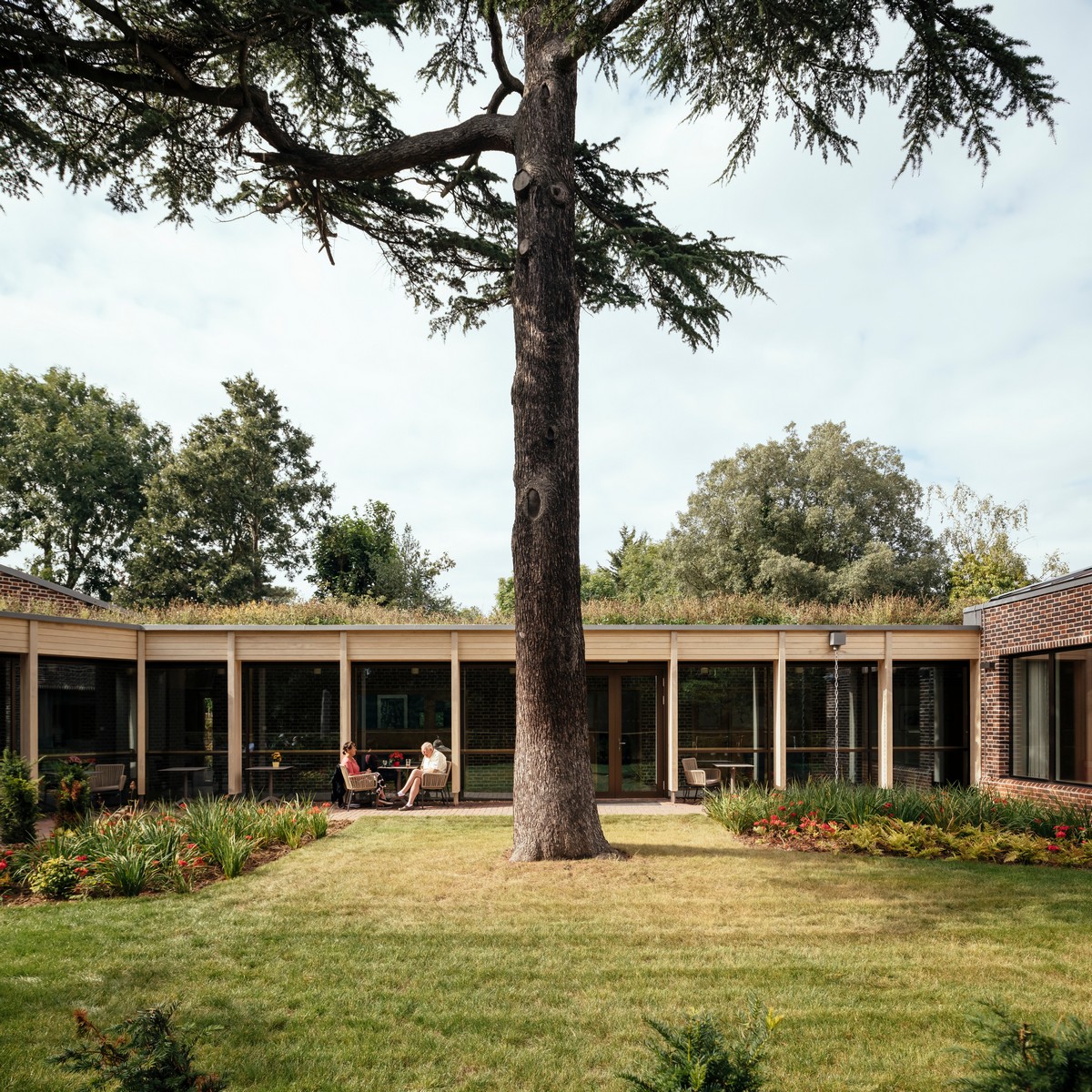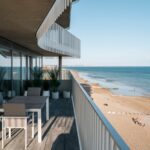RIBA Special Awards 2011 Shortlist, Buildings, UK Architecture Links, Projects
RIBA Special Awards 2011
Royal Institute of British Architects – Prize Winners
Winners added 2 Oct 2011
8 Sep 2011
RIBA Special Awards Shortlist for 2011
– RIBA Client of the Year award
Every year the The Royal Institute of British Architects shortlists projects for the RIBA Awards. From the shortlist another shortlist is taken for the Stirling Prize which is announced in October. The RIBA Special Awards help celebrate other aspects. Last year there were six Special Awards that honoured the UK’s best new school buildings, conservation projects, public spaces, smaller projects and Client of the Year.
Today we show releases for two of these and will post releases for the others when they are announced.
The six RIBA Special Awards are:-
RIBA Client of the Year
The Royal Shakespeare Company won the 2011 RIBA Client of the Year supported by the Bloxham Charitable Trust. The award recognizes the role good clients play in the delivery of fine architecture.
Stephen Lawrence Prize
St. Patrick’s School Library and Music Room in north-west London by Coffey Architects won the RIBA’s 2011 Stephen Lawrence Prize. Set up in memory of Stephen Lawrence who was setting out on the road to becoming an architect when he was murdered in 1993 and funded by the Marco Goldschmied Foundation, the prize rewards the best examples of projects that have a construction budget of less than £1 million and is intended to encourage fresh talent working with smaller budgets.
Yet to be announced:
RIBA CABE Public Space Award
Crown Estate Conservation Award
The RIBA Sorrell Foundation Schools Award
RIBA Manser Medal 2010 Shortlist
Shortlist for the 2011 RIBA Client of the Year award
The Royal Institute of British Architects (RIBA) today announces the six shortlisted clients nominated for the 2011 Client of the Year award, sponsored by the Bloxham Charitable Trust.
The RIBA Client of the Year award honours the key role that a good client plays in the creation of fine architecture. They consider clients of the year’s RIBA Award-winning schemes but take into account a track record of previous successful commissioning, particularly where this has led to earlier RIBA Awards.
The winner will be announced at the RIBA Stirling Prize 2011 Dinner in association with The Architects’ Journal and Benchmark on Saturday 1 October 2011 at Magna Science Adventure Centre in Rotherham.
2011 RIBA Client of the Year shortlist
• Chatham Historic Dockyard Trust
• Land Securities
• Living Architecture
• The London Borough of Hackney
• The Royal Shakespeare Company
• The Royal Society for the Protection of Birds (RSPB)
The judges included Tom Bloxham MBE; architect Deborah Saunt, Chair of Awards and Tony Chapman, Head of RIBA Awards.
2011 RIBA Client of the Year shortlisted entrants in more detail
Chatham Historic Dockyard Trust – statement by van Heyningen and Haward Architects The Trust is rewarding to work for; in some respects they are a challenging client, with very high expectations and slim budgets, and the site has particular constraints. However, they are very involved in all their projects, working constructively with their design teams to achieve the best design, and creatively exploiting funding opportunities and procurement strategies. They provide strong leadership, and the framework within which the individual contributions of their partners, consultants and contractors can come together to best effect.
No. 1 Smithery, Chatham
van Heyningen and Haward
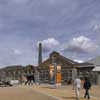
photo © James Brittain
Land Securities – statement by Sidell Gibson Partnership
We have worked with Land Securities in the past and have successfully completed many projects with them. Creating a sustainable environment is part of Land Securities’ vision for shaping the future of property and this project is not an exception. The combination of the carbon reduction initiatives and other sustainability measures, including a car free environment, extensive cyclist provisions for the office users, rainwater harvesting and green roof areas (recognised by the Excellent BREEAM ratings for the office) we hope will ensure that One New Change sets the standard for others to follow for many years to come.
One New Change, London
Ateliers Jean Nouvel with Sidell Gibson Architects

photo © Paul Riddle
Living Architecture – statement by Mole Architects
Living Architecture are the kind of clients that one dreams of. With a stated purpose of bringing modern architecture to the public’s attention one might think that they would be content with appointing internationally respected architects, and giving them free rein. The reality is slightly different, and infinitely better. Living Architecture are not only supportive and appreciative of the ideas of their architects, they are also demanding, attentive, and interested in the finest details. It is the process of continuous engagement in the architectural process from concept to occupation that makes them exceptional. Rarely is an architect interrogated to secure both intellectual rigour and practicality every step along the way; the buildings are the result of this process.
Balancing Barn, Suffolk
MVDRV
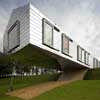
photo : Edmund Sumner
The London Borough of Hackney – statement by Hopkins Architects
Hackney set high standards in terms of design, health and safety, inclusivity, sustainability and security. They set tough cost targets for the project but encouraged and supported us in looking at innovative ways to tackle the issue. Hackney had high aspirations for a building of quality, which also provided excellent value for money. The Council played a significant role in coordinating and managing the expectations of the numerous stakeholders in the project. Working with Hackney was an exemplar of the co-design process.
Hackney Service Centre, London E8
Hopkins Architects
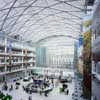
photograph © Paul Tyagi
The Royal Shakespeare Company – statement by Bennetts Associates
The Royal Shakespeare Company has been an exceptional client, not only for the main theatre and several other building projects but also for its relationships with the design team and local community. Their projects represent a formidable portfolio of high quality patronage, but they have also been carried out in a collaborative way, with the RSC’s theatrical designers fully integrated with the architect-led teams. Despite being multi-headed, the client came to coherent decisions by virtue of an equally collaborative management team that included the Chair and Vice-Chair, Chief Executive, Artistic Director and Project Director. In addition, the RSC and Bennetts Associates established a rigorous consultation process with a host of locally based individuals and groups, which led directly to a bold planning consent for the main Royal Shakespeare Theatre and a revitalised relationship between the RSC and the town of Stratford-upon-Avon.
Royal Shakespeare Theatre, Stratford-upon-Avon – winner
Bennetts Associates
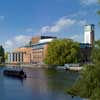
image © Peter Cook
The Royal Society for the Protection of Birds (RSPB) – statement by Peter Beard_LANDROOM
As an organisation the RSPB have recognised the key role architecture has to play as an essential component in supporting their core programme of conservation of wildlife and the natural world. In recent years the RSPB have shown a highly active support and promotion of innovation in architecture through their commissioning of architects for a range of projects. They have recognised that the involvement of architects in even modest-scaled projects can have a big impact. This invitation for involvement has not been limited to buildings but has also included architectural commissions for other elements of reserve infrastructure including, bridges, boardwalks and furniture, critical components in the management and conservation of the organisation’s landscape assets.
Reception Hide Complex, Titchwell
Haysom Ward Miller Architects
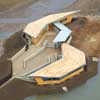
photo © Mike Page
Shortlist for the 2011 RIBA Stephen Lawrence Prize
Six projects feature on the RIBA Stephen Lawrence Prize 2011 shortlist A cantilevered ‘hovering house’, a superb bird-watching centre, a delightfully light and spacious terraced house, an ingenious school extension, a cleverly designed dental practice and a contemporary family home incorporating a small eighteenth century ruin are all contenders for this year’s RIBA Stephen Lawrence Prize 2011.
Drawn from the RIBA Award-winning buildings presented earlier this year, the winner of the RIBA Stephen Lawrence Prize will be announced at the RIBA Stirling Prize 2011 Dinner in association with The Architects’ Journal and Benchmark on Saturday 1 October 2011 at Magna Science Adventure Centre in Rotherham.
The RIBA Stephen Lawrence Prize is funded by the Marco Goldschmied Foundation, and was set up in memory of the teenager who was setting out on the road to becoming an architect when he was murdered in 1993. The prize, which rewards the best examples of projects that have a construction budget of less than £1 million, is intended to encourage fresh talent working with smaller budgets.
RIBA Stephen Lawrence Shortlist
• Brown’s Dental Practice, Ivybridge by David Sheppard Architects
• Hoxton House, London N1 by David Mikhail Architects
• Marshland Discovery Zone, Purfleet by Peter Beard_LANDROOM
• St. Patrick’s School Library and Music Room, London NW5 by Coffey Architects
• Ty-Hedfan, Brecon, Powys by Featherstone Young
• White House, Isle of Coll by WT Architecture
The judges included the architect and past President of the RIBA Marco Goldschmied, Doreen Lawrence OBE, mother of Stephen Lawrence and founder of the Stephen Lawrence Centre, and last year’s winner, Philip Gumuchdjian.
Citations for each Stephen Lawrence Prize shortlisted building
Brown’s Dental Practice
Ivybridge
Architect: David Sheppard Architects
Brown’s Dental Practice
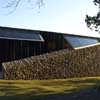
photo : Joakim Boren
This is a feast for the senses: from the overt tactility of the rough-hewn stone walling, to the scent and smooth warmth of the birch plywood that lines the interior spaces. The quality of light in the treatment rooms is particularly poetic, with frameless glass rooflights capturing dappled light as it falls through the trees.
The architect has worked hard to balance the patients’ requirement for privacy with the practitioners’ need for an airy light-filled workspace. The narrow slots between the planks of cedar cladding are glazed, giving patients glimpses of the outdoor world. The delight in material and texture is a welcome contrast to the functionality and lack of care so often associated with healthcare buildings.
Hoxton House
Buttesland Street, London N1
Architect: David Mikhail Architects
Hoxton House

photograph © Tim Crocker
Britain has an enormous stock of traditional terraced houses, which increasingly struggle to meet the needs of contemporary living – clearly a significant challenge. This typical four-storey London terraced house is a case in point, characterised by multiple levels and cramped dark rooms set around a winding staircase. The clue to realising the full potential of this house came in the small rear yard.
The lower-ground and ground floors have been unified by the addition of a double-height extension, just one-metre deep. This has allowed the ground floor to be pulled away from the existing rear wall, uniting the living spaces on both floors with a modest double-height volume. This project achieves a delightful sense of space and light that is hard to believe possible in a house of this type.
Marshland Discovery Zone
Purfleet
Architect: Peter Beard_LANDROOM
Marshland Discovery Zone
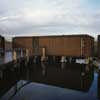
photo © Sue Barr
Three rusty old sea containers dumped on a marsh would not normally be perceived as having any aesthetic or practical value. Still less might they be thought capable of forming a place for exploration and delight. But the inherent rawness of these corten containers allows them to retain their industrial identity even as they are re-invented as places for observation and learning. Minor modifications have been cleverly inserted to maintain an ambiguity of meaning that is entirely appropriate to the activity and setting.
This project is not concerned with the traditional architectural skills of managing form and materials, rather it is about revaluing things that on the surface no longer seem to have any use. And encouraging others to do likewise.
St Patrick’s School Library and Music Room
Holmes Road, London NW5
Architect: Coffey Architects
St. Patricks School Library and Music Room – winner

photograph © Tim Soar
‘Less is More’ would seem to sum up this tiny yet delightful and ingenious school extension providing a library, music room and store room. The building has a simplicity that comes from a straightforward plan and the prevailing expression of just two self-finish materials. The space is lined on three sides by bookshelves at ground level and the storage display of musical instruments on the first floor mezzanine. The central volume created by this arrangement is open and flexible to allow for both musical practise/performance and also as a group reading area – in fact whatever the school requires.
However, this simple arrangement is literally given a third dimension by the openable glass wall which, with a freestanding external canopy, creates an informal proscenium for play.
Ty Hedfan
Pontfaen, Brecon, Powys
Architect: Featherstone Young
Ty-Hedfan
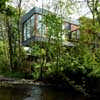
picture © Featherstone Young
Referencing the traditional Welsh long house form, the building cantilevers out over the site, cleverly avoiding the planning constraint on building within seven meters of the nearby river. The name of the house means ‘hovering house’. The design uses a tall, striking and expressive nine metre tall dry-stone wall as the knuckle between the rectangular form of the main house and the bedroom wing, which is buried into the hillside under a green sedum roof. The best views are from the cantilevered living room where you feel that you are amongst the trees. The buried wing of the house has generous full-height glazing and three rooflights permitting daylight to permeate into the deeper parts. These are intriguingly detailed as if they were wooden cattle toughs in a field.
The White House
Griffipol, Isle of Coll, Inner Hebrides
Architect: WT Architecture
White House
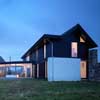
photo : Andrew Lee
The architects and client sought to create a contemporary family home incorporating the listed shell of a small eighteenth century ruined house on site. The partial re-use of this existing house delineates this new development which is composed of two accommodation blocks connected by a glazed living-dining space. While the ruin has been consolidated and parts are incorporated within the new building, the separation between historic and contemporary is overt. A new timber structure perches itself on a substantial dry stone wall, built on old enclosure lines and re-using stone from the site, allowing a light weight break with the local vernacular while being grounded in its robust landscape and tradition. The house thus sits comfortably within this extraordinarily beautiful landscape.
RIBA Special Awards Shortlist – Winners in 2010
Comments re the RIBA Special Awards welcome: info(at)e-architect.com
Location: Rugby, England, UK
RIBA Special Awards Winners – 2010
Crown Estate Conservation Award
Neues Museum, Berlin
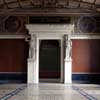
photograph : Ute Zscharnt
RIBA Client of the Year
Hammerson
RIBA CABE Public Space Award
The Pier Head and Canal Link, Liverpool
Stephen Lawrence Prize
The Artist’s House, London
The RIBA Sorrell Foundation Schools Award
St Luke’s CE Primary School, Wolverhampton
RIBA Manser Medal 2010 Shortlist
RIBA Manser Medal 2010
RIBA Stirling Prize
The RIBA Stirling Prize is awarded to the architects of the building that has made the greatest contribution to British architecture in the past year. The prize will be presented on 1 Oct 2011
Stirling Prize – Shortlist
Comments / photos for the RIBA Special Awards 2011 News Page page welcome

